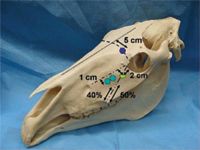LA Respiratory Issues
How to – Sinus trephination
Indications
Diagnostic or therapeutic trephination is indicated in cases of unilateral purulent nasal discharge with primary signs associated with the paranasal sinus. Sinusitis may be associated with dental disease, tumors, or primary infection. Diagnostic trephination can confirm the presence of pus in the sinus; permits aspiration of sinus contents for cytology, biopsy, or culture ands sensitivity testing; and provides a portal for therapeutic irrigation
Relevant anatomy

Preoperative management
Food restrictions: NA
NSAIDs/analgesics: Recommended
Antibiotics: NA; sample collection for culture is probably indicated
Tetanus prophylaxis is recommended.
Local blocks: Local infiltration
Position/preparation:
Usually performed with the horse standing using local anesthetic infiltration and chemical restraint when needed. Clip and prep the intended area. Anesthesia is provided by local infiltration of a 2% solution of lidocaine. The boundaries of the maxillary sinus are: a line drawn from the rostral end of the facial crest to the infraorbital foramen, the dorsal margin is a line from the infraorbital foramen to the medial canthus of the eye, the caudal margin is a line (parallel to the rostral margin) from the medial canthus of the eye to the caudal aspect of the facial crest, and the ventral margin is the facial crest. These boundaries provide maximal exposure of he maxillary sinus while protecting the vulnerable infraorbital canal and nasolacrimal duct.
Surgery Supplies:
- Michele trephine or steinman pin and chuck.
Surgical procedure
A 1-cm stab incision of the skin and periosteum is sufficient for diagnostic trephination. A Steinmann intramedullary pin, 3/16 or 1/4 inch in diameter, is used to penetrate the bone. The pin should be checked with just sufficient trocar point exposed to penetrate the bone, but without risk of damaging deeper structures. In standing horses the pin and handle can be thrown violently if the horse jerks its head, be careful! The portal provides access for aspiration, biopsy instrument, a 4-mm arthroscope, or a lavage catheter. The sinus should be irrigated with warm sterile, polyionic solution and discharge from the nostril examined
Postoperative care
- The portal remains open for 10 to 12 days for repeat irrigation. The incision should not be sutured but allowed to heal by second intention. Larger holes heal within 3 to 4 weeks.
Complications
- Iatrogenic damage to the nasolacrimal duct is possible
Videos
Resources
Paranasal sinus anatomy and trephination technique (Proceedings)

